Fanha ’aniyan Pulan CHamoru



WPCOUNCIL.ORG
January 23, 2023 - February 10, 2024
Traditional/Cultural Knowledge
Our manamko (elders) carry the knowledge of Chamorro traditional cultural fishing practices and why we care to protect our resources. They are a ready resource because they know how certain species are caught and prepared. Fish are typically ma-patti (shared) during village fiestas, family gatherings, and special community events.


When talayerus (throw netters) gather along the shores, it is a sign of the arrival of forage fish like mañahak (juvenile rabbitfish).
If you don't catch your own, atulai (bigeye scad) is commonly available from roadside vendors in Guam when in season. Support your local fishermen by buying fresh locally caught fish.
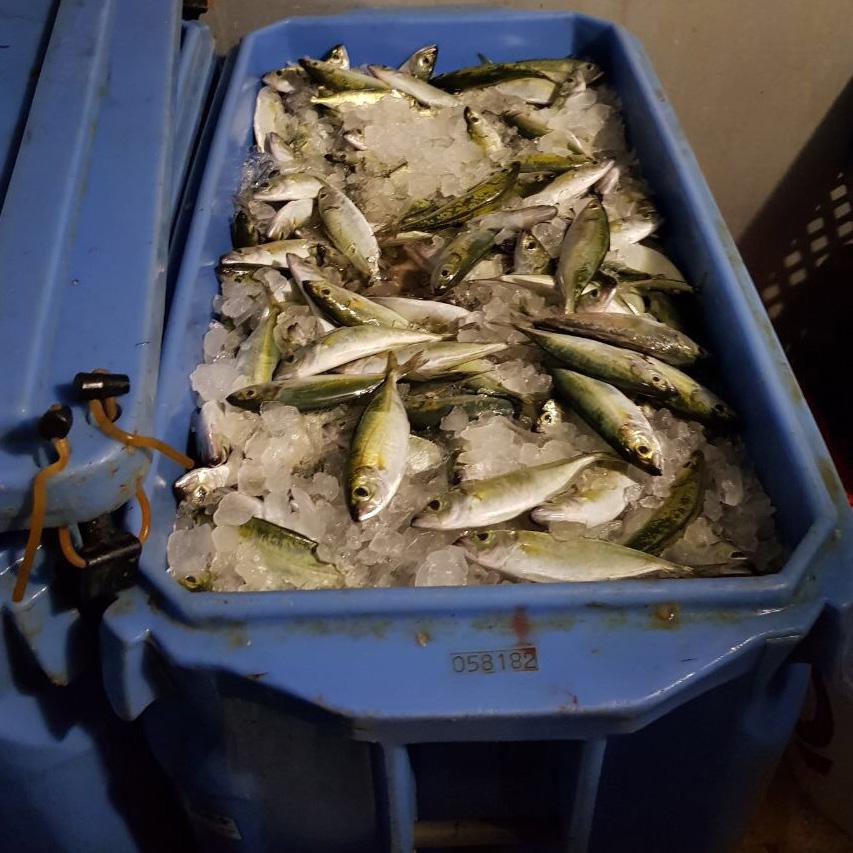
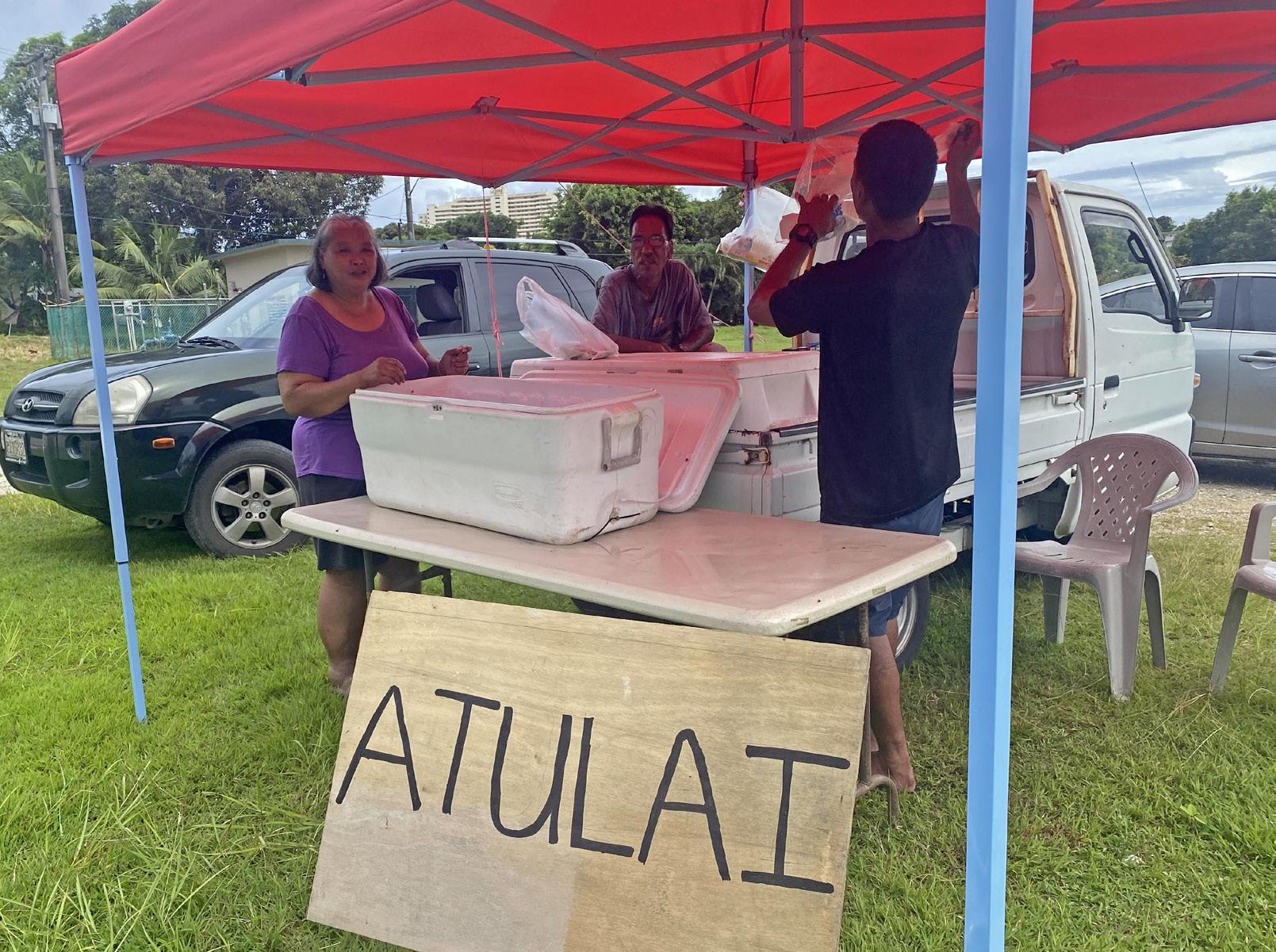 Photo: Division of Aquatic and Wildlife Resources
Photo: Felix Reyes
Photo: Felix Reyes
Photo: Division of Aquatic and Wildlife Resources
Photo: Felix Reyes
Photo: Felix Reyes

MOON-RELATED OBSERVATIONS AND ACTIVITIES 23 24 25 26 27 28 29 30 31 1 23456789 10 11 12 13 14 15 16 17 18 19 20 MON TUE WED THU FRI SAT SUN MON TUE WED THU FRI SAT SUN MON TUE WED THU FRI SAT SUN MON TUE WED THU FRI SAT SUN MON -1 0 1 2 3 -1 0 1 2 3 -1 0 1 2 3 6N6 6N6 6N6 6N6 6N6 6N6 6N6 6N6 6N6 6N6 6N6 6N6 6N6 6N6 6N6 6N6 6N6 6N6 6N6 6N6 6N6 6N6 6N6 6N6 6N6 6N6 6N6 6N6 6N6 January February R 08:01 S 19:48 R 08:52 S 20:51 R 09:38 S 21:48 R 10:20 S 22:43 R 11:00 S 23:36 R 11:39 S 00:28 R 12:20 S 01:19 R 13:02 S 02:11 R 13:47 S 03:05 R 14:35 S 03:58 R 15:25 S 04:49 R 16:17 S 05:38 R 17:09 S 06:24 R 18:00 S 07:06 R 18:50 S 07:45 R 19:38 S 08:22 R 20:25 S 08:58 R 21:12 S 09:33 R 21:59 S 10:09 R 22:47 S 10:46 R 23:38 S 11:28 R 00:33 S 12:14 R 01:32 S 13:07 R 02:35 S 14:06 R 03:40 S 15:11 R 04:43 S 16:19 R 05:42 S 17:26 R 06:36 S 18:29 January 23 - February 20 Ineru 23 - Fibreru 20, 2023 Umayangan Sinahen Håcha Dengnga Humunaohuyong Pulan E’egeng Kuåtto Mangguånte Kuåtto Kosiente Sumenhomhom Sinahi Kuåtto Ketai’ Empe’ Dalalai Pulan Sinahen Gunum Pulan Gualåffon Sinahen Ulu Sumahi I Pilan Pånglao Tunas/ Echong Hihot Talo’ Sinahen Fiti Mumalilingu Empe’ Finaloffan Puti’on Sinahen Lima Atahguen Atdao Halomsahguan Sinahen Tulu Gumofatanon Tunas Talo’ Sinahen Hugua Luma’annok Humomhom
Environment

Botague (mahimahi) typically bites from January to April, blue marlin from June to October, and wahoo from November to December. Mañahak (juvenile rabbitfish) runs are seasonal during April or May and again during September or October.

The seasonality of fish often coincides with natural cues on land. For example, some attribute the arrival of termites in the early evening or the ripening of the kamachile’ fruit (Manila tamarind) with the arrival of the mañahak.
Guam has two seasons: dry from January to June and rainy from July to December. Rough water tends to occur more often during the rainy season and into the winter months, tapering off during February. When the water gets rough, it's a safe bet to fish near the fish aggregating devices (FADs) as they are more accessible.
 Photo: Jimmy Badong
Photo: Felix Reyes
Photo: Jimmy Badong
Photo: Felix Reyes

MOON-RELATED OBSERVATIONS AND ACTIVITIES 21 22 23 24 25 26 27 2812 3456789 10 11 12 13 14 15 16 17 18 19 20 21 22 TUE WED THU FRI SAT SUN MON TUE WED THU FRI SAT SUN MON TUE WED THU FRI SAT SUN MON TUE WED THU FRI SAT SUN MON TUE WED -1 0 1 2 3 -1 0 1 2 3 -1 0 1 2 3 6N6 6N6 6N6 6N6 6N6 6N6 6N6 6N6 6N6 6N6 6N6 6N6 6N6 6N6 6N6 6N6 6N6 6N6 6N6 6N6 6N6 6N6 6N6 6N6 6N6 6N6 6N6 6N6 6N6 6N6 February Marc h R 07:25 S 19:30 R 08:10 S 20:27 R 08:52 S 21:23 R 09:33 S 22:17 R 10:14 S 23:10 R 10:57 S 00:04 R 11:42 S 00:58 R 12:30 S 01:52 R 13:20 S 02:44 R 14:11 S 03:34 R 15:04 S 04:21 R 15:55 S 05:05 R 16:46 S 05:45 R 17:35 S 06:22 R 18:22 S 06:58 R 19:09 S 07:34 R 19:56 S 08:09 R 20:44 S 08:47 R 21:35 S 09:27 R 22:28 S 10:11 R 23:25 S 11:01 R 00:26 S 11:56 R 01:28 S 12:57 R 02:30 S 14:02 R 03:29 S 15:07 R 04:23 S 16:10 R 05:13 S 17:11 R 05:59 S 18:09 R 06:42 S 19:06 February 21 - March 22 Fibreru 21 - Måtso 22, 2023 Tumaiguini Sinahen Håcha Dengnga Humunaohuyong Pulan E’egeng Kuåtto Mangguånte Sinahi Kuåtto Kosiente Sumenhomhom Kumaninifes Kuåtto Ketai’ Empe’ Dalalai Pulan Sinahen Gunum Pulan Gualåffon Sinahen Ulu Sumahi I Pilan Pånglao Tunas/ Echong Hihot Talo’ Sinahen Fiti Mumalilingu Empe’ Finaloffan Puti’on Sinahen Lima Atahguen Atdao Halomsahguan Sinahen Tulu Gumofatanon Tunas Talo’ Sinahen Hugua Luma’annok Humomhom
Seasonality/Sustainability

Fishermen highly anticipate the start of the atulai (bigeye scad) and i’e (juvenile jacks) season, when they catch for family and patté (sharing) with friends. The atulai season lasts from one to six months starting in late spring. I’e are common during the months of July through October but are found in greater abundance during August. Mañahak (juvenile rabbitfish) typically make their run two times a year, usually around April to May and again in October. The runs are similar to a salmon run up the river, except the mañahak run onto the reef flats from the open ocean. The schools can be quite large with millions of these small fish. As they transition into adults, mañahak are called sesyun and can be caught year round. Both stages are a highly prized delicacy.

When the atulai runs, fishermen are elbow to elbow casting for a few to take home.
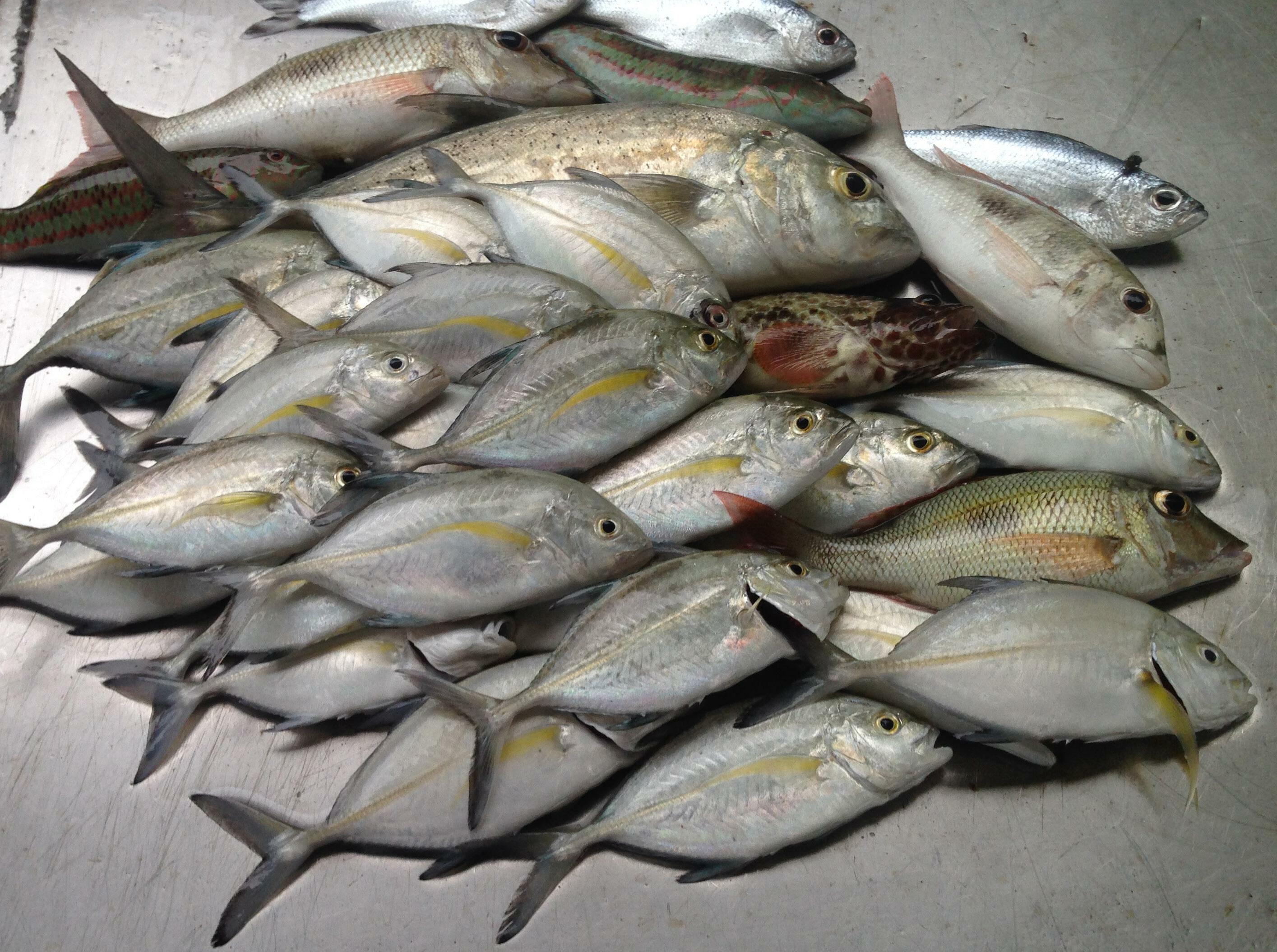
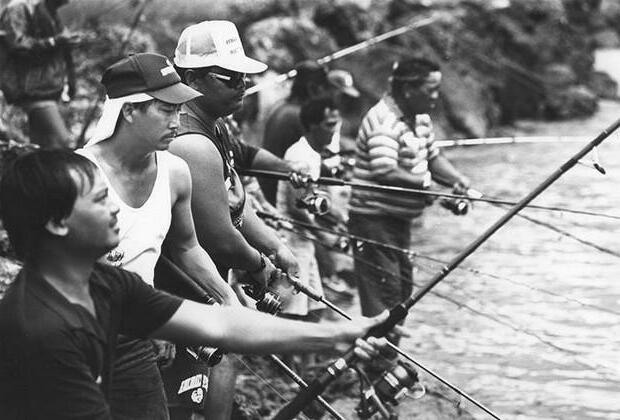 Fishermen know to respect our culture and its long history of caring for our environment, taking only what we need from our ocean.
Sesyun.
Photo: WPRFMC
A pile of mostly i’e. Photo: Felix Reyes
Photo: Division of Aquatic and Wildlife Resources
Fishermen know to respect our culture and its long history of caring for our environment, taking only what we need from our ocean.
Sesyun.
Photo: WPRFMC
A pile of mostly i’e. Photo: Felix Reyes
Photo: Division of Aquatic and Wildlife Resources

MOON-RELATED OBSERVATIONS AND ACTIVITIES 23 24 25 26 27 28 29 30 31 1 23456789 10 11 12 13 14 15 16 17 18 19 20 THU FRI SAT SUN MON TUE WED THU FRI SAT SUN MON TUE WED THU FRI SAT SUN MON TUE WED THU FRI SAT SUN MON TUE WED THU -1 0 1 2 3 -1 0 1 2 3 -1 0 1 2 3 6N6 6N6 6N6 6N6 6N6 6N6 6N6 6N6 6N6 6N6 6N6 6N6 6N6 6N6 6N6 6N6 6N6 6N6 6N6 6N6 6N6 6N6 6N6 6N6 6N6 6N6 6N6 6N6 6N6 March April R 07:23 S 20:01 R 08:05 S 20:56 R 08:48 S 21:51 R 09:34 S 22:47 R 10:21 S 23:42 R 11:12 S 00:36 R 12:04 S 01:28 R 12:56 S 02:17 R 13:48 S 03:01 R 14:39 S 03:43 R 15:29 S 04:21 R 16:17 S 04:57 R 17:04 S 05:33 R 17:51 S 06:09 R 18:40 S 06:46 R 19:30 S 07:25 R 20:23 S 08:09 R 21:20 S 08:57 R 22:20 S 09:51 R 23:22 S 10:51 R 00:24 S 11:53 R 01:22 S 12:57 R 02:17 S 13:59 R 03:07 S 14:59 R 03:52 S 15:56 R 04:35 S 16:52 R 05:16 S 17:46 R 05:57 S 18:41 March 23 - April 20 Måtso 23 - Abrit 20, 2023 Maimo Sinahen Håcha Dengnga Humunaohuyong Pulan E’egeng Kuåtto Mangguånte Kuåtto Kosiente Sumenhomhom Sinahi Kuåtto Ketai’ Empe’ Dalalai Pulan Sinahen Gunum Pulan Gualåffon Sinahen Ulu Sumahi I Pilan Pånglao Tunas/ Echong Hihot Talo’ Sinahen Fiti Mumalilingu Empe’ Finaloffan Puti’on Sinahen Lima Atahguen Atdao Halomsahguan Sinahen Tulu Gumofatanon Tunas Talo’ Sinahen Hugua Luma’annok Humomhom
Traditional/Cultural Knowledge
What is the relationship between pelagic fish and seasonal fish like ti’ao (juvenile goatfish) and mañahak (juvenile rabbitfish)? Fishermen know that different fish have different seasons. Sometimes the arrival of large pelagic fish is foreseen when fishers start to see an abundance of mañahak and other forage fish being eaten in the open water. They adapt their lures to reflect the species of bait fish being eaten by pelagic fish to improve their catch.
Fishermen wait for the season of bigger fish to arrive, but sometimes small fish take the lures. When relatively small pelagic fish start to be caught, fishermen know it is a sign that their larger relatives are soon to arrive.



Having modern fishing equipment does not always equate to catching more and larger fish. Early fishermen, using basic fishing tools available during their time, were able to catch some of the largest fish around.
 Photo: Division of Aquatic and Wildlife Resources
Photo: Felix Reyes
Photo: Felix Reyes
Photo: Division of Aquatic and Wildlife Resources
Photo: Felix Reyes
Photo: Felix Reyes

MOON-RELATED OBSERVATIONS AND ACTIVITIES 21 22 23 24 25 26 27 28 29 30 123456789 10 11 12 13 14 15 16 17 18 19 20 FRI SAT SUN MON TUE WED THU FRI SAT SUN MON TUE WED THU FRI SAT SUN MON TUE WED THU FRI SAT SUN MON TUE WED THU FRI SAT -1 0 1 2 3 -1 0 1 2 3 -1 0 1 2 3 6N6 6N6 6N6 6N6 6N6 6N6 6N6 6N6 6N6 6N6 6N6 6N6 6N6 6N6 6N6 6N6 6N6 6N6 6N6 6N6 6N6 6N6 6N6 6N6 6N6 6N6 6N6 6N6 6N6 6N6 April May R 06:39 S 19:36 R 07:24 S 20:32 R 08:11 S 21:29 R 09:01 S 22:25 R 09:53 S 23:18 R 10:46 S 00:09 R 11:39 S 00:56 R 12:31 S 01:39 R 13:21 S 02:18 R 14:09 S 02:55 R 14:56 S 03:30 R 15:43 S 04:06 R 16:31 S 04:42 R 17:21 S 05:21 R 18:14 S 06:04 R 19:10 S 06:51 R 20:11 S 07:45 R 21:14 S 08:44 R 22:17 S 09:47 R 23:18 S 10:51 R 00:14 S 11:54 R 01:04 S 12:53 R 01:50 S 13:50 R 02:33 S 14:45 R 03:13 S 15:38 R 03:53 S 16:31 R 04:34 S 17:25 R 05:16 S 18:20 R 06:02 S 19:16 April 21 - May 20 Abrit 21 - Måyu 20, 2023 Umatalaf Sinahen Håcha Dengnga Humunaohuyong Pulan E’egeng Kuåtto Mangguånte Sinahi Kuåtto Kosiente Sumenhomhom Kumaninifes Kuåtto Ketai’ Empe’ Dalalai Pulan Sinahen Gunum Pulan Gualåffon Sinahen Ulu Sumahi I Pilan Pånglao Tunas/ Echong Hihot Talo’ Sinahen Fiti Mumalilingu Empe’ Finaloffan Puti’on Sinahen Lima Atahguen Atdao Halomsahguan Sinahen Tulu Gumofatanon Tunas Talo’ Sinahen Hugua Luma’annok Humomhom
Food Safety

It is important to understand the fish you catch, including identifying the species, knowing when they are caught throughout the year and what they eat. This helps fishers know whether the fish is safe to eat or when they taste better (usually earlier in the season). Mamulan (mature jacks or giant trevally) and many reef fish more than 6 pounds tend to be poisonous (ciguatoxic) due to the accumulation of toxins. Small marlin under 130 pounds taste better than their larger relatives. The same is true about skipjack tuna and wahoo; their meat is tender and more flavorful.

Mañahak (juvenile rabbitfish) taste better before they have fed after crossing into the lagoons. After they feed, their color changes from silver (bottom) to spotted (top) and they pop when fried due to the algae in their stomachs, making them less desirable.
 Photo: Michael Dueñas
Photo: Felix Reyes
Michael Dueñas demonstrates the parts of a small tuna to youth at the Guam Fishermen’s Cooperative Association, teaching them about food safety and how to take care of their catch. Eat only fresh fish that have clear eyes, a clean smell and are recently caught.
Photo: Michael Dueñas
Photo: Felix Reyes
Michael Dueñas demonstrates the parts of a small tuna to youth at the Guam Fishermen’s Cooperative Association, teaching them about food safety and how to take care of their catch. Eat only fresh fish that have clear eyes, a clean smell and are recently caught.

May 21 - June 18 Måyu 21 - Huniu 18, 2023 MOON-RELATED OBSERVATIONS AND ACTIVITIES 21 22 23 24 25 26 27 28 29 30 31123456789 10 11 12 13 14 15 16 17 18 SUN MON TUE WED THU FRI SAT SUN MON TUE WED THU FRI SAT SUN MON TUE WED THU FRI SAT SUN MON TUE WED THU FRI SAT SUN -1 0 1 2 3 -1 0 1 2 3 -1 0 1 2 3 6N6 6N6 6N6 6N6 6N6 6N6 6N6 6N6 6N6 6N6 6N6 6N6 6N6 6N6 6N6 6N6 6N6 6N6 6N6 6N6 6N6 6N6 6N6 6N6 6N6 6N6 6N6 6N6 6N6 May June R 06:51 S 20:13 R 07:43 S 21:08 R 08:36 S 22:01 R 09:30 S 22:49 R 10:22 S 23:34 R 11:13 S 00:16 R 12:02 S 00:54 R 12:49 S 01:27 R 13:35 S 02:02 R 14:22 S 02:38 R 15:10 S 03:15 R 16:01 S 03:56 R 16:56 S 04:41 R 17:55 S 05:32 R 18:58 S 06:30 R 20:04 S 07:34 R 21:08 S 08:40 R 22:07 S 09:45 R 23:01 S 10:48 R 23:49 S 11:46 R 00:33 S 12:41 R 01:13 S 13:34 R 01:53 S 14:27 R 02:33 S 15:19 R 03:14 S 16:13 R 03:58 S 17:08 R 04:45 S 18:04 R 05:35 S 19:00 Lumuhu Sinahen Håcha Dengnga Humunaohuyong Pulan E’egeng Kuåtto Mangguånte Kuåtto Kosiente Sumenhomhom Sinahi Kuåtto Ketai’ Empe’ Dalalai Pulan Sinahen Gunum Pulan Gualåffon Sinahen Ulu Sumahi I Pilan Pånglao Tunas/ Echong Hihot Talo’ Sinahen Fiti Mumalilingu Empe’ Finaloffan Puti’on Sinahen Lima Atahguen Atdao Halomsahguan Sinahen Tulu Gumofatanon Tunas Talo’ Sinahen Hugua Luma’annok Humomhom
Traditional/Cultural Knowledge

To identify fish, our manamko (ancestors) named fish based on their features or characteristics. The ababang looks like its namesake, a butterfly, and a wrasse called palakse’ (slippery) was named for the coat of slime on its body. The i’e (juvenile jack) got its name from the sound it makes when caught.


There are so many fish species in Guam’s waters that it is sometimes difficult to identify which species they are. The måtan haggan (emperor) was named because its eyes look like those of a sea turtle, but some also call it måtan hagon because the eyes also resemble plant leaves.
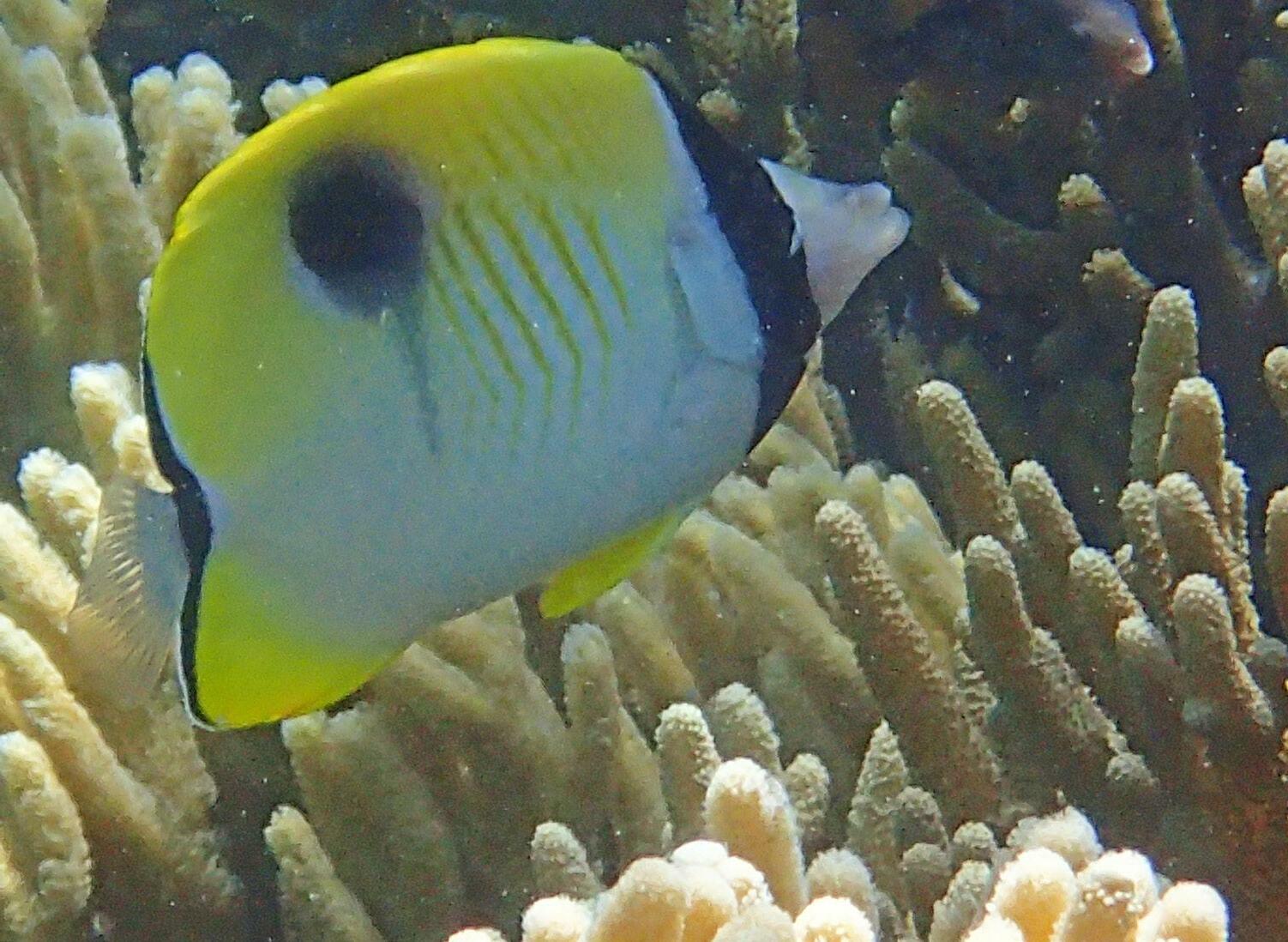 Photos: Division of Aquatic and Wildlife Resources
Photos: Division of Aquatic and Wildlife Resources

June 19 - July 18 Huniu 19 - Huliu 18, 2023 MOON-RELATED OBSERVATIONS AND ACTIVITIES 19 20 21 22 23 24 25 26 27 28 29 3012345678 9101112131415161718 MON TUE WED THU FRI SAT SUN MON TUE WED THU FRI SAT SUN MON TUE WED THU FRI SAT SUN MON TUE WED THU FRI SAT SUN MON TUE -1 0 1 2 3 -1 0 1 2 3 -1 0 1 2 3 6N6 6N6 6N6 6N6 6N6 6N6 6N6 6N6 6N6 6N6 6N6 6N6 6N6 6N6 6N6 6N6 6N6 6N6 6N6 6N6 6N6 6N6 6N6 6N6 6N6 6N6 6N6 6N6 6N6 6N6 June July R 06:28 S 19:53 R 07:21 S 20:43 R 08:14 S 21:29 R 09:06 S 22:12 R 09:55 S 22:51 R 10:43 S 23:27 R 11:29 S 00:02 R 12:14 S 00:37 R 13:01 S 01:10 R 13:50 S 01:48 R 14:41 S 02:30 R 15:38 S 03:18 R 16:39 S 04:13 R 17:44 S 05:15 R 18:50 S 06:21 R 19:53 S 07:29 R 20:51 S 08:35 R 21:43 S 09:37 R 22:30 S 10:35 R 23:12 S 11:30 R 23:53 S 12:23 R 00:33 S 13:16 R 01:13 S 14:09 R 01:56 S 15:04 R 02:42 S 15:59 R 03:31 S 16:54 R 04:22 S 17:48 R 05:15 S 18:39 R 06:09 S 19:26 Makmamao Sinahen Håcha Dengnga Humunaohuyong Pulan E’egeng Kuåtto Mangguånte Sinahi Kuåtto Kosiente Sumenhomhom Kumaninifes Kuåtto Ketai’ Empe’ Dalalai Pulan Sinahen Gunum Pulan Gualåffon Sinahen Ulu Sumahi I Pilan Pånglao Tunas/ Echong Hihot Talo’ Sinahen Fiti Mumalilingu Empe’ Finaloffan Puti’on Sinahen Lima Atahguen Atdao Halomsahguan Sinahen Tulu Gumofatanon Tunas Talo’ Sinahen Hugua Luma’annok Humomhom
Fish Data Collection

Open ocean fishing by Chamorros of long ago was only allowed for the men in the family. Women fished closer to shore or near the reef margin. Today, the number of women interested in learning is increasing.
In Guam, the Division of Aquatic and Wildlife Resources collects fisherydependent data directly from fishermen using creel surveys from shore and boat-based fishers. Good data allows fishery managers to make wellinformed decisions to ensure the sustainability of fish populations so we can fish forever!

Council scholarship recipient Leilani Sablan conducts an independent creel survey to track changes in target reef fish.
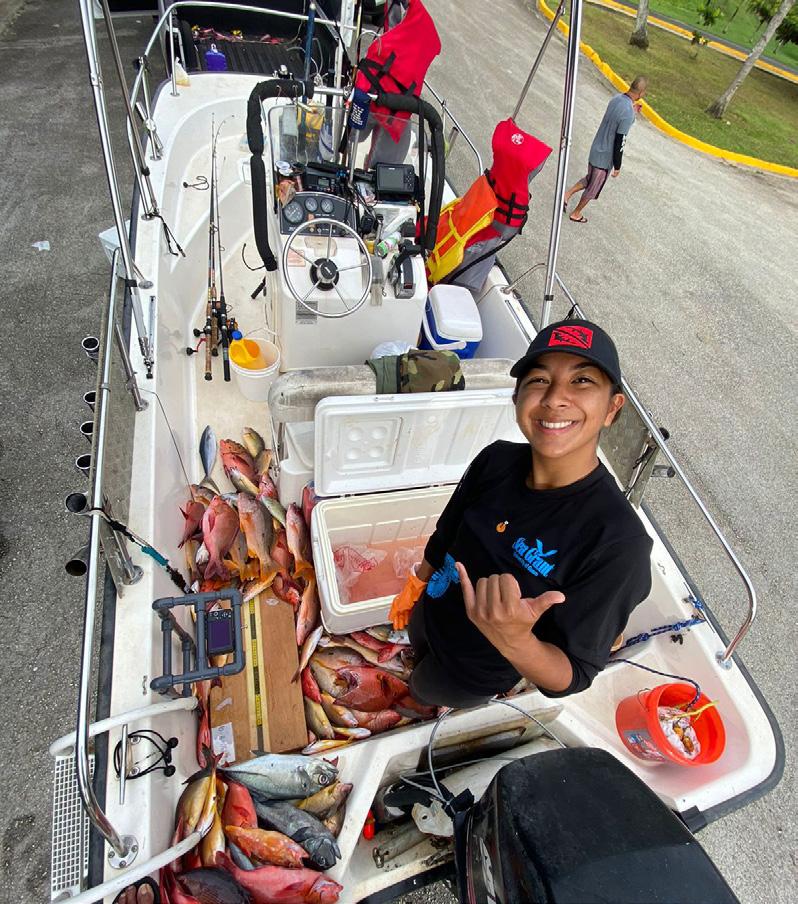
 Photo: Leilani Sablan
Photo: Audrey Toves
Photo: Felix Reyes
Photo: Leilani Sablan
Photo: Audrey Toves
Photo: Felix Reyes

July 19 - August 16 Huliu 19 - Agosto 16, 2023 MOON-RELATED OBSERVATIONS AND ACTIVITIES 19 20 21 22 23 24 25 26 27 28 29 30 311234567 89 10 11 12 13 14 15 16 WED THU FRI SAT SUN MON TUE WED THU FRI SAT SUN MON TUE WED THU FRI SAT SUN MON TUE WED THU FRI SAT SUN MON TUE WED -1 0 1 2 3 -1 0 1 2 3 -1 0 1 2 3 6N6 6N6 6N6 6N6 6N6 6N6 6N6 6N6 6N6 6N6 6N6 6N6 6N6 6N6 6N6 6N6 6N6 6N6 6N6 6N6 6N6 6N6 6N6 6N6 6N6 6N6 6N6 6N6 6N6 July August R 07:01 S 20:09 R 07:51 S 20:49 R 08:39 S 21:26 R 09:25 S 22:01 R 10:10 S 22:36 R 10:56 S 23:10 R 11:42 S 23:45 R 12:31 S 00:23 R 13:24 S 01:07 R 14:21 S 01:57 R 15:23 S 02:55 R 16:28 S 03:58 R 17:33 S 05:06 R 18:34 S 06:14 R 19:30 S 07:20 R 20:20 S 08:21 R 21:06 S 09:20 R 21:49 S 10:15 R 22:30 S 11:10 R 23:11 S 12:04 R 23:54 S 12:59 R 00:40 S 13:55 R 01:28 S 14:50 R 02:18 S 15:44 R 03:11 S 16:36 R 04:04 S 17:24 R 04:57 S 18:08 R 05:47 S 18:48 Mananaf Sinahen Håcha Dengnga Humunaohuyong Pulan E’egeng Kuåtto Mangguånte Kuåtto Kosiente Sumenhomhom Sinahi Kuåtto Ketai’ Empe’ Dalalai Pulan Sinahen Gunum Pulan Gualåffon Sinahen Ulu Sumahi I Pilan Pånglao Tunas/ Echong Hihot Talo’ Sinahen Fiti Mumalilingu Empe’ Finaloffan Puti’on Sinahen Lima Atahguen Atdao Halomsahguan Sinahen Tulu Gumofatanon Tunas Talo’ Sinahen Hugua Luma’annok Humomhom
Fishing Clubs/Education

Being in a fishing club brings a sense of community and security, especially for the youth, and helps foster lifelong hobbies and friendships. Members learn about modern fishing methods, including information about fish-specific baits, lures, depths and fishing areas around the island.

Cradle to grave. Southern High School Fishing Club members share knowledge about fishing using modern boats and tools with elementary school students.
 Photo: Stephen Meno
Photo: Felix Reyes
Photo: Stephen Meno
Photo: Felix Reyes

August 17 - September 15 Agosto 17 - Septembre 15, 2023 MOON-RELATED OBSERVATIONS AND ACTIVITIES 17 18 19 20 21 22 23 24 25 26 27 28 29 30 3112345 6789 10 11 12 13 14 15 THU FRI SAT SUN MON TUE WED THU FRI SAT SUN MON TUE WED THU FRI SAT SUN MON TUE WED THU FRI SAT SUN MON TUE WED THU FRI -1 0 1 2 3 -1 0 1 2 3 -1 0 1 2 3 6N6 6N6 6N6 6N6 6N6 6N6 6N6 6N6 6N6 6N6 6N6 6N6 6N6 6N6 6N6 6N6 6N6 6N6 6N6 6N6 6N6 6N6 6N6 6N6 6N6 6N6 6N6 6N6 6N6 6N6 August September R 06:36 S 19:27 R 07:22 S 20:02 R 08:08 S 20:36 R 08:53 S 21:10 R 09:39 S 21:45 R 10:26 S 22:22 R 11:17 S 23:02 R 12:11 S 23:47 R 13:09 S 00:40 R 14:11 S 01:40 R 15:14 S 02:44 R 16:16 S 03:51 R 17:13 S 04:57 R 18:06 S 06:01 R 18:54 S 07:02 R 19:39 S 08:00 R 20:22 S 08:57 R 21:05 S 09:53 R 21:48 S 10:50 R 22:34 S 11:47 R 23:22 S 12:44 R 00:13 S 13:39 R 01:06 S 14:32 R 01:59 S 15:21 R 02:52 S 16:07 R 03:43 S 16:48 R 04:33 S 17:26 R 05:20 S 18:02 R 06:06 S 18:37 Semo Sinahen Håcha Dengnga Humunaohuyong Pulan E’egeng Kuåtto Mangguånte Sinahi Kuåtto Kosiente Sumenhomhom Kumaninifes Kuåtto Ketai’ Empe’ Dalalai Pulan Sinahen Gunum Pulan Gualåffon Sinahen Ulu Sumahi I Pilan Pånglao Tunas/ Echong Hihot Talo’ Sinahen Fiti Mumalilingu Empe’ Finaloffan Puti’on Sinahen Lima Atahguen Atdao Halomsahguan Sinahen Tulu Gumofatanon Tunas Talo’ Sinahen Hugua Luma’annok Humomhom
Food Security/Health
Healthy ecosystems produce healthy fish to feed the community. Locally caught fish are fresher than imported fish. Buying local reduces waste and supports efforts to sustainably manage our fisheries by understanding what is caught, how much is caught and where it is caught.

Fishermen showcase their catch that will be sold to restaurants on Guam to promote food security.
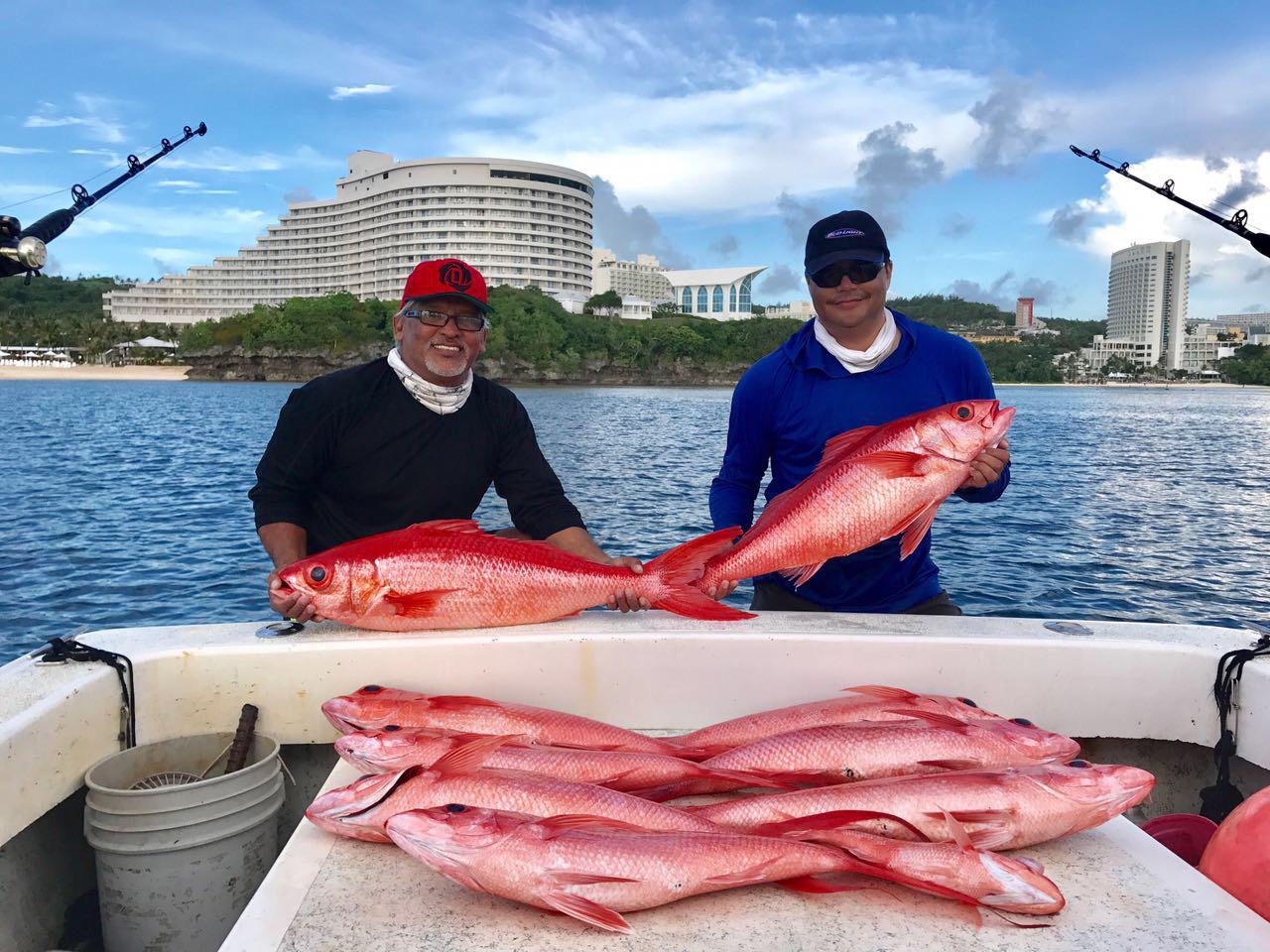
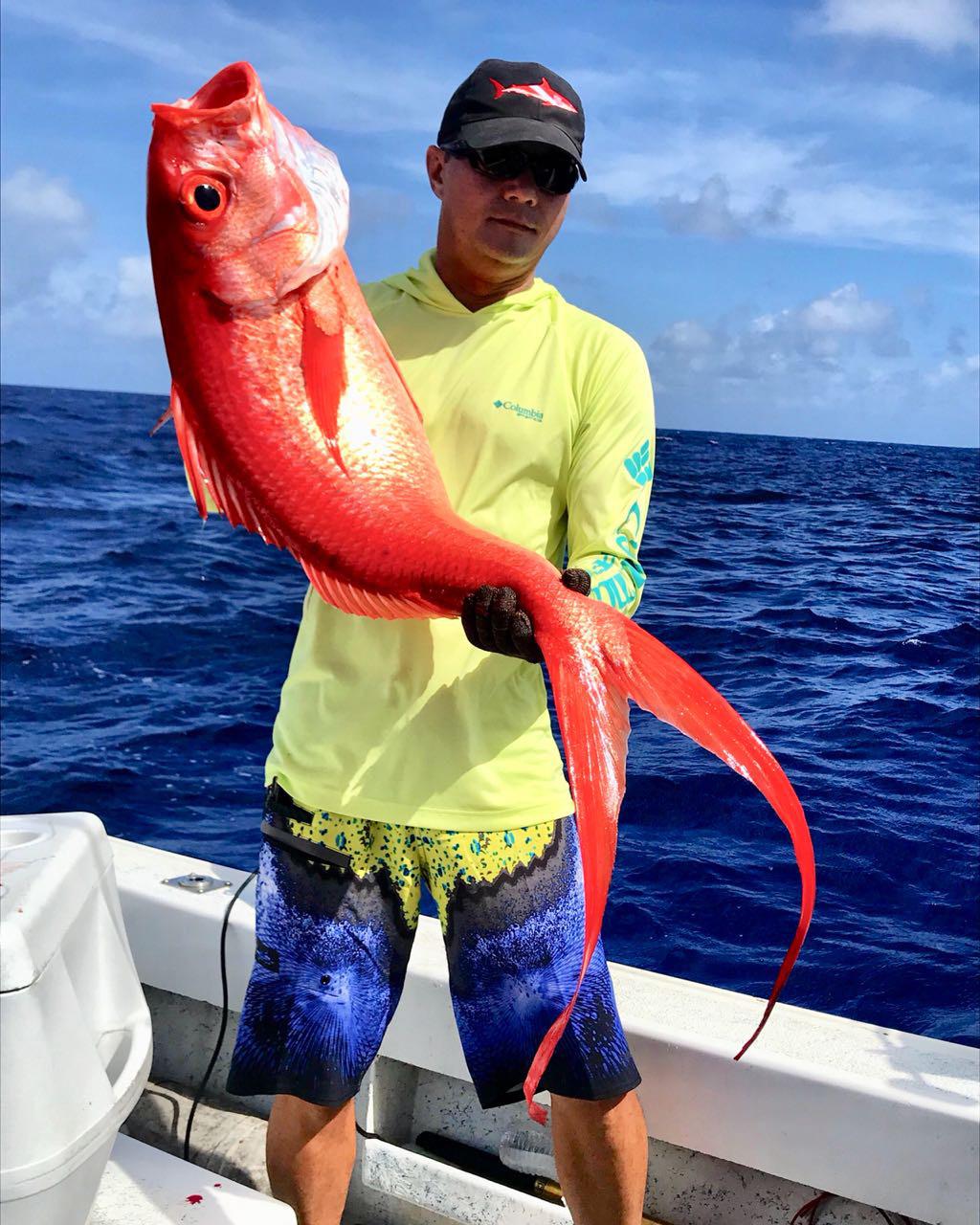
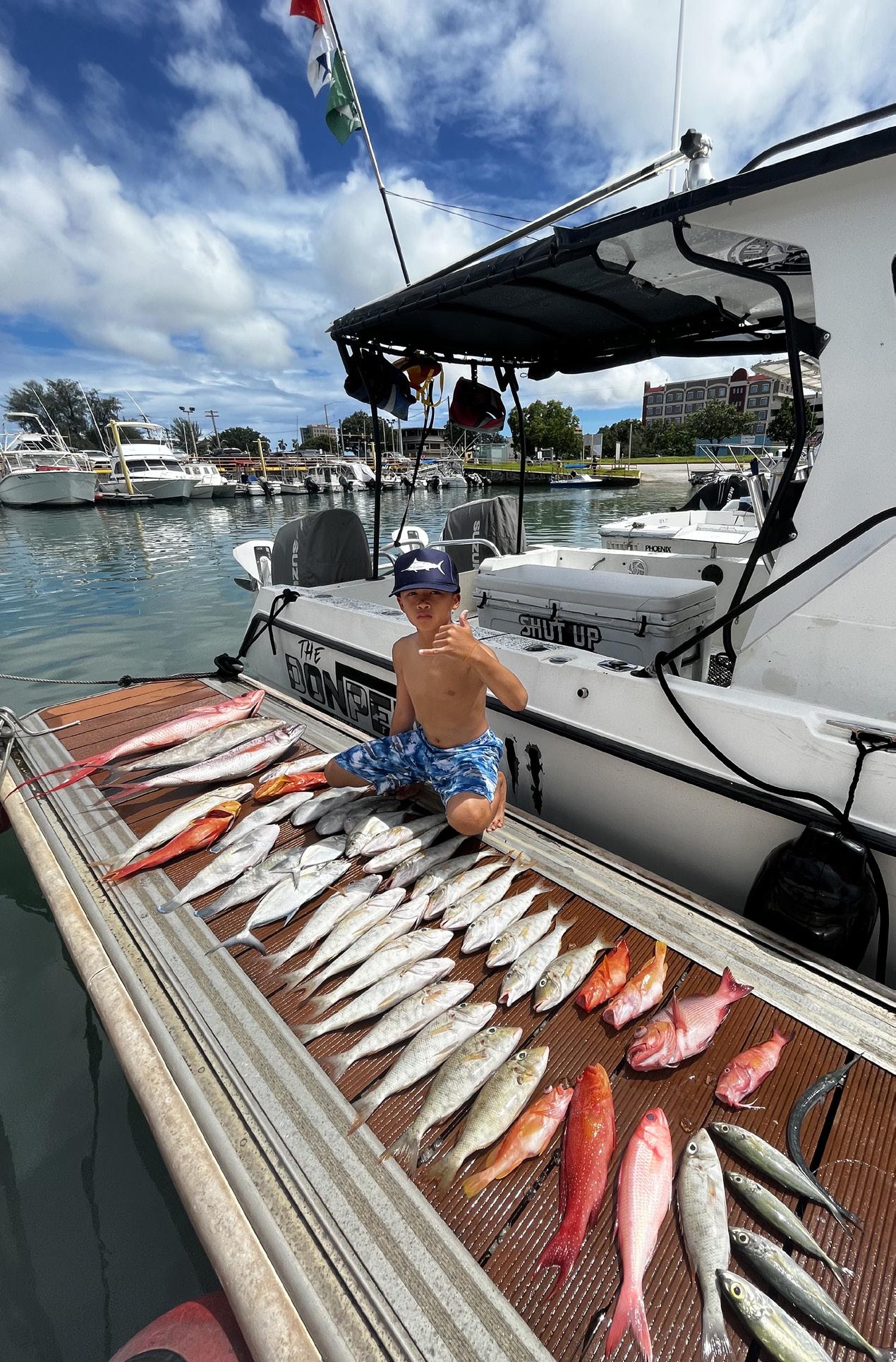 Photos: James Borja
Photo: Don Pedro Makaveli Cruz
Photos: James Borja
Photo: Don Pedro Makaveli Cruz

September 16 - October 15 Septembre 16 - Oktubri 15, 2023 MOON-RELATED OBSERVATIONS AND ACTIVITIES 16 17 18 19 20 21 22 23 24 25 26 27 28 29 3012345 6789 10 11 12 13 14 15 SAT SUN MON TUE WED THU FRI SAT SUN MON TUE WED THU FRI SAT SUN MON TUE WED THU FRI SAT SUN MON TUE WED THU FRI SAT SUN -1 0 1 2 3 -1 0 1 2 3 -1 0 1 2 3 6N6 6N6 6N6 6N6 6N6 6N6 6N6 6N6 6N6 6N6 6N6 6N6 6N6 6N6 6N6 6N6 6N6 6N6 6N6 6N6 6N6 6N6 6N6 6N6 6N6 6N6 6N6 6N6 6N6 6N6 September October R 06:51 S 19:11 R 07:37 S 19:46 R 08:24 S 20:22 R 09:13 S 21:01 R 10:06 S 21:45 R 11:02 S 22:33 R 12:01 S 23:27 R 13:02 S 00:29 R 14:02 S 01:34 R 15:00 S 02:38 R 15:53 S 03:42 R 16:42 S 04:43 R 17:28 S 05:41 R 18:11 S 06:39 R 18:54 S 07:37 R 19:38 S 08:34 R 20:24 S 09:33 R 21:13 S 10:32 R 22:04 S 11:30 R 22:58 S 12:25 R 23:52 S 13:17 R 00:46 S 14:04 R 01:38 S 14:46 R 02:28 S 15:26 R 03:16 S 16:02 R 04:02 S 16:37 R 04:48 S 17:11 R 05:34 S 17:45 R 06:21 S 18:22 Tenhos Sinahen Håcha Dengnga Humunaohuyong Pulan E’egeng Kuåtto Mangguånte Kuåtto Kosiente Sumenhomhom Kuåtto Ketai’ Empe’ Dalalai Pulan Sinahen Gunum Pulan Gualåffon Sinahen Ulu Sumahi I Pilan Pånglao Tunas/ Echong Hihot Talo’ Sinahen Fiti Mumalilingu Empe’ Finaloffan Puti’on Sinahen Lima Atahguen Atdao Halomsahguan Sinahen Tulu Gumofatanon Tunas Talo’ Sinahen Hugua Luma’annok Humomhom Sinahi Kumaninifes
Fishing Derbies/Education

Join the Guam Division of Aquatic and Wildlife Resources Kid’s Fishing Derbies to learn or teach about the importance of data collection and fisheries management strategies. Teaching kids early to fish also teaches them to respect our resources and be responsible stewards of the sea.
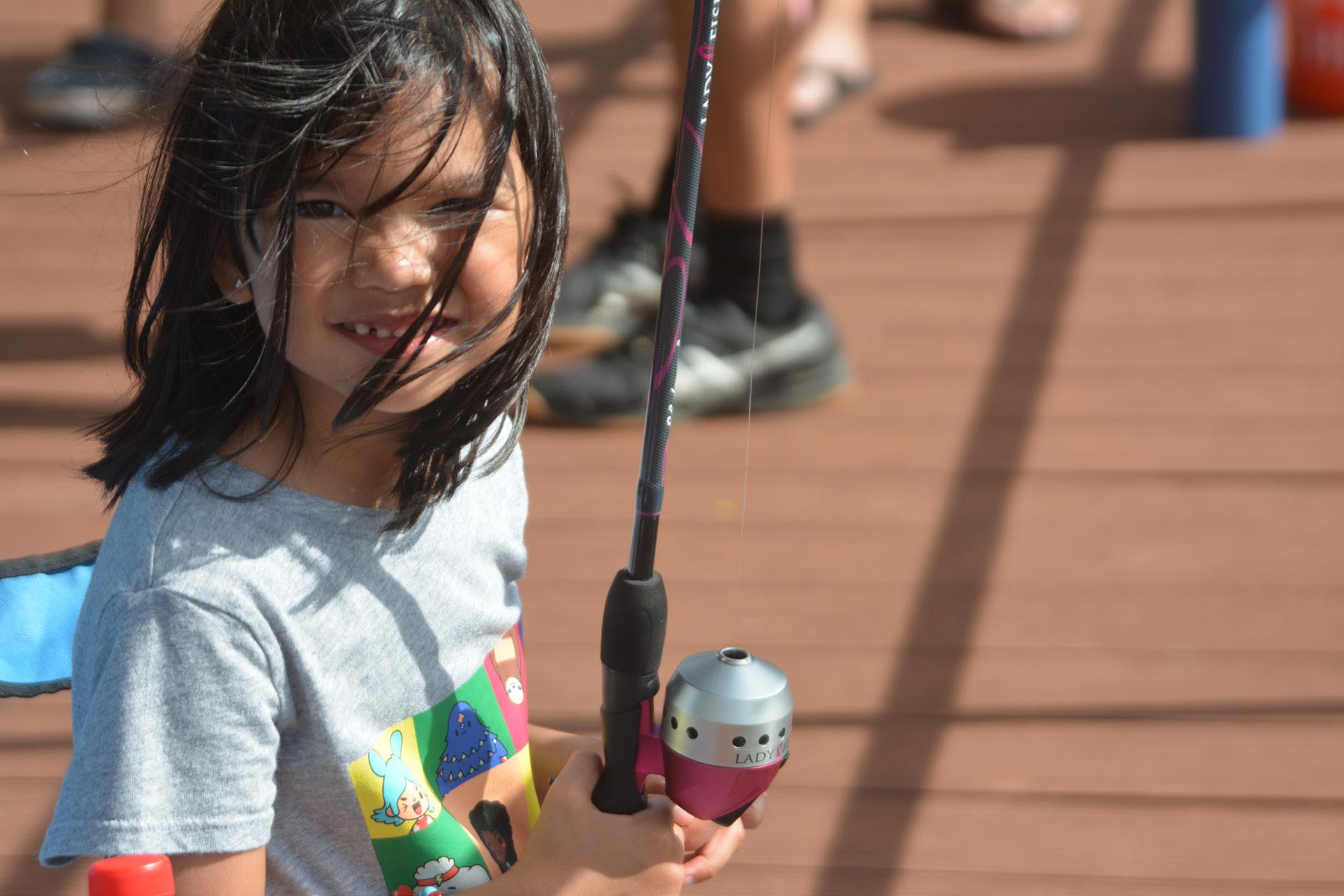

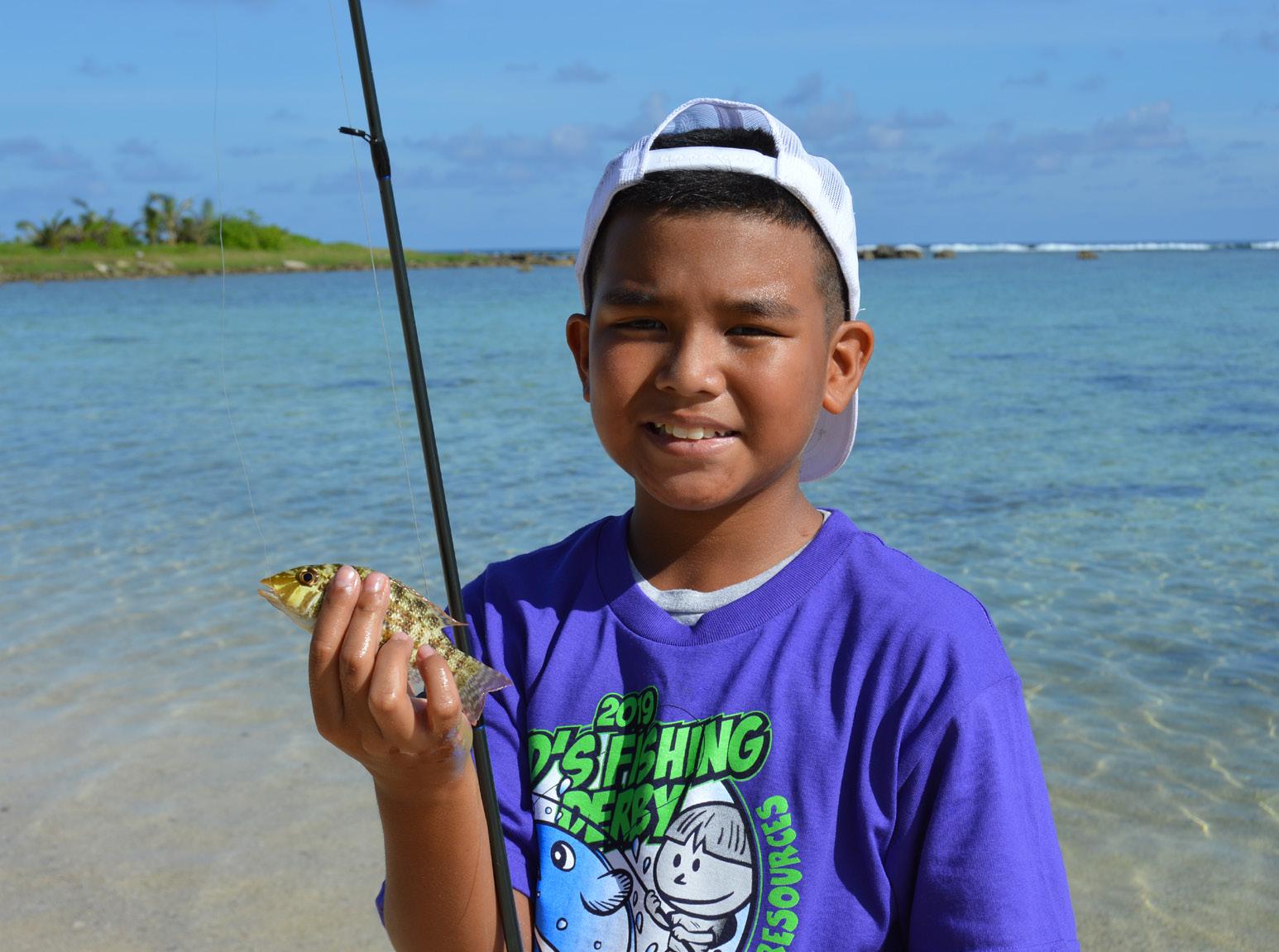 Photos: Felix Reyes
Photos: Felix Reyes

October 16 - November 14 Oktubri 16 - Nubembre 14, 2023 MOON-RELATED OBSERVATIONS AND ACTIVITIES 16 17 18 19 20 21 22 23 24 25 26 27 28 29 30 311234 56789 10 11 12 13 14 MON TUE WED THU FRI SAT SUN MON TUE WED THU FRI SAT SUN MON TUE WED THU FRI SAT SUN MON TUE WED THU FRI SAT SUN MON TUE -1 0 1 2 3 -1 0 1 2 3 -1 0 1 2 3 6N6 6N6 6N6 6N6 6N6 6N6 6N6 6N6 6N6 6N6 6N6 6N6 6N6 6N6 6N6 6N6 6N6 6N6 6N6 6N6 6N6 6N6 6N6 6N6 6N6 6N6 6N6 6N6 6N6 6N6 October November R 07:10 S 19:01 R 08:02 S 19:43 R 08:57 S 20:30 R 09:56 S 21:23 R 10:56 S 22:21 R 11:56 S 23:23 R 12:53 S 00:27 R 13:46 S 01:29 R 14:34 S 02:29 R 15:20 S 03:27 R 16:03 S 04:23 R 16:45 S 05:19 R 17:28 S 06:17 R 18:12 S 07:15 R 19:00 S 08:15 R 19:51 S 09:15 R 20:45 S 10:13 R 21:40 S 11:07 R 22:36 S 11:57 R 23:29 S 12:42 R 00:21 S 13:23 R 01:10 S 14:00 R 01:56 S 14:35 R 02:42 S 15:09 R 03:28 S 15:44 R 04:14 S 16:19 R 05:03 S 16:57 R 05:54 S 17:39 R 06:49 S 18:26 Lumamlam Sinahen Håcha Dengnga Humunaohuyong Pulan E’egeng Kuåtto Mangguånte Sinahi Kuåtto Kosiente Sumenhomhom Kumaninifes Kuåtto Ketai’ Empe’ Dalalai Pulan Sinahen Gunum Pulan Gualåffon Sinahen Ulu Sumahi I Pilan Pånglao Tunas/ Echong Hihot Talo’ Sinahen Fiti Mumalilingu Empe’ Finaloffan Puti’on Sinahen Lima Atahguen Atdao Halomsahguan Sinahen Tulu Gumofatanon Tunas Talo’ Sinahen Hugua Luma’annok Humomhom
Fishing Tools

Our taotaomo’na (ancestors) used traditional plant fibers and even human bone or fish bones to craft fishing tools like spears, hooks and gorges to catch fish of all sizes, including marlin! Fishing line and nets were made of plant materials. Bone needles were used to make or mend fishing nets. Readily available stone and shell sinkers were used to bring bait closer to the ocean floor where more fish are located.
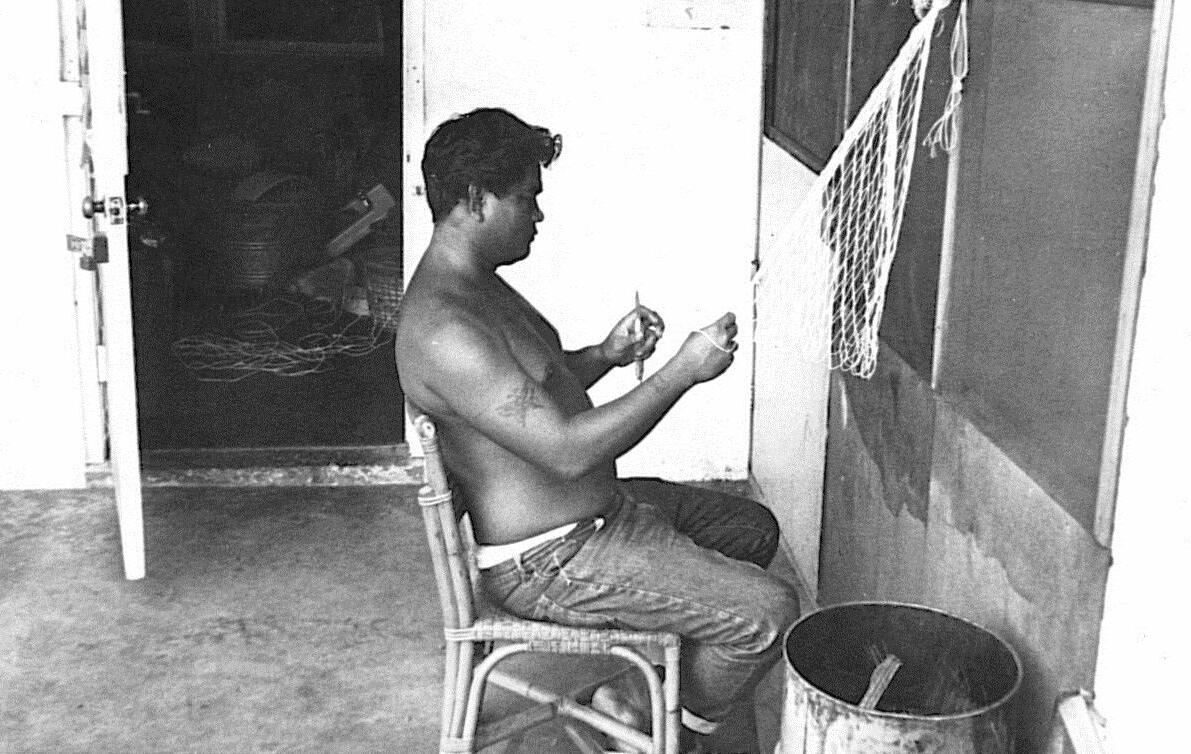
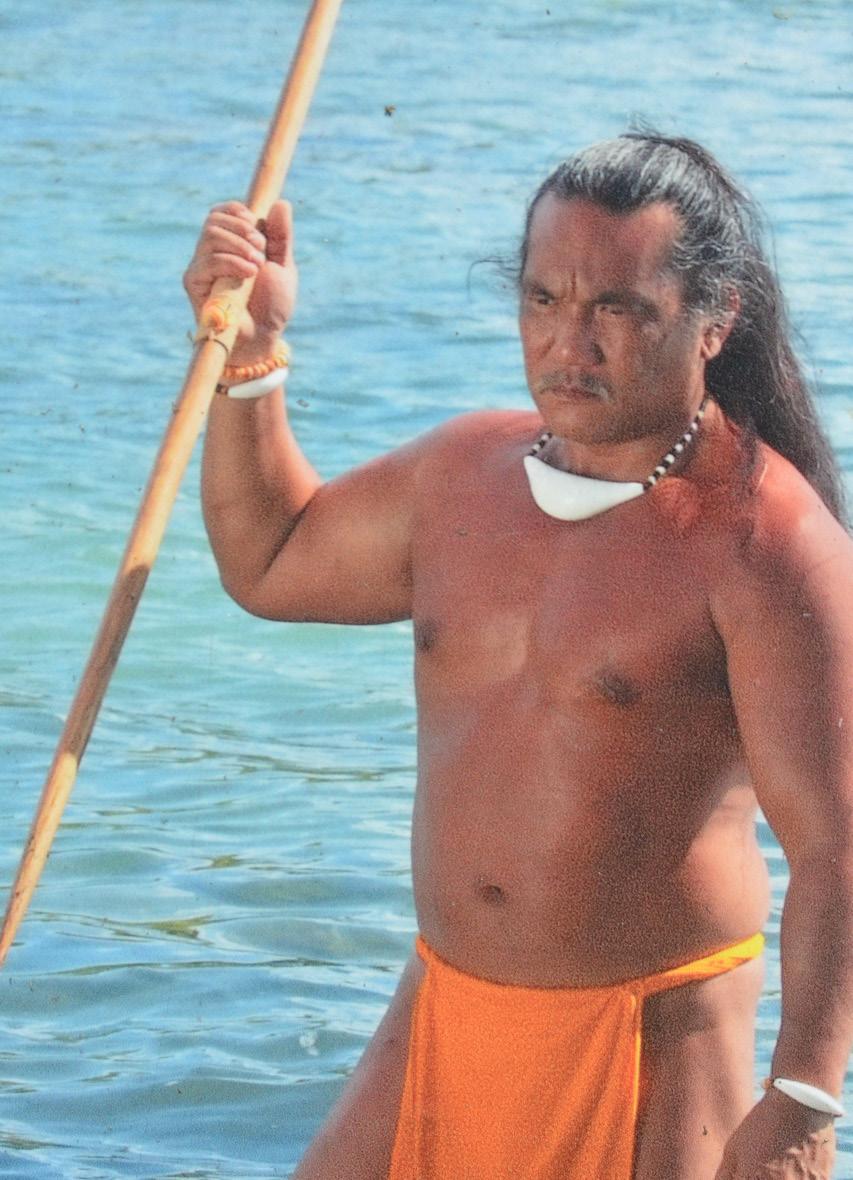
Today, some of these tools have been adapted. Now all use monofilament to make talaya (throw nets) or chenchulu (surround nets), carbon fiber fishing poles, electric reels and aluminum or fiberglass boats with gas or diesel engines. These modern tools allow fishermen to travel farther in the ocean and stay out longer to catch fish.
Fishing hooks, weight and gorges used by ancient Chamorros.

1. This ~500-year old fish hook is made of human bone and is the point of a 2-piece fish hook. The shank may have been made of wood, or some type of material that does not last in the ground. 2. A pearl shell fish hook with a notched shank, ~500-1000 years old. 3. A fishing weight crafted from a giant clam shell (Tridacna), ~2,500 years old. 4. The largest of the 3 gorges is made of helmet shell (Cassis), while the other 2 are from a giant clam shell (Tridacna).
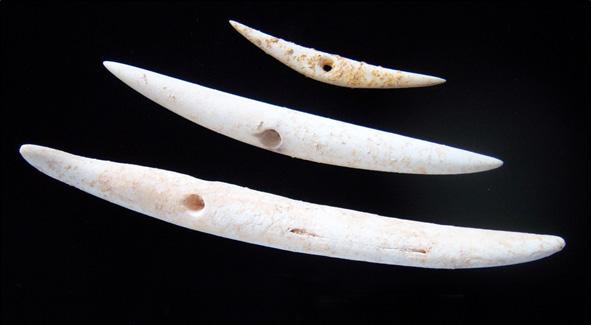
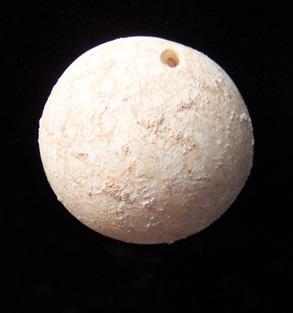
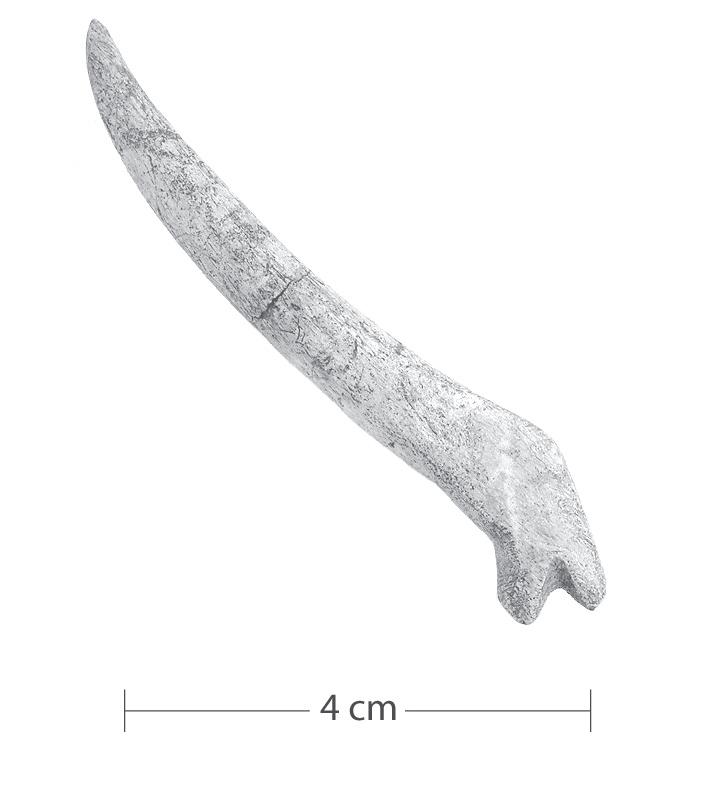

1 2 3 4
3.9 cm 4.6 cm 8 cm / 14 cm / 18 cm
Photos: Rick Schaefer1, Judith Amesbury2,3,4
Regular maintenance and repair of fishing tools is an important part of fishing.
Photo: Division of Aquatic and Wildlife Resources
Photo: DAWR
Photo: Felix Reyes

November 15 - December 13 Nubembre 15 - Disembre 13, 2023 MOON-RELATED OBSERVATIONS AND ACTIVITIES 15 16 17 18 19 20 21 22 23 24 25 26 27 28 29 301234 56789 10 11 12 13 WED THU FRI SAT SUN MON TUE WED THU FRI SAT SUN MON TUE WED THU FRI SAT SUN MON TUE WED THU FRI SAT SUN MON TUE WED -1 0 1 2 3 -1 0 1 2 3 -1 0 1 2 3 6N6 6N6 6N6 6N6 6N6 6N6 6N6 6N6 6N6 6N6 6N6 6N6 6N6 6N6 6N6 6N6 6N6 6N6 6N6 6N6 6N6 6N6 6N6 6N6 6N6 6N6 6N6 6N6 6N6 November December R 07:48 S 19:18 R 08:49 S 20:15 R 09:50 S 21:17 R 10:49 S 22:20 R 11:43 S 23:22 R 12:32 S 00:22 R 13:17 S 01:19 R 13:59 S 02:14 R 14:40 S 03:09 R 15:21 S 04:04 R 16:04 S 05:00 R 16:49 S 05:59 R 17:38 S 06:58 R 18:31 S 07:58 R 19:27 S 08:55 R 20:23 S 09:47 R 21:18 S 10:35 R 22:11 S 11:18 R 23:02 S 11:57 R 23:49 S 12:33 R 00:35 S 13:07 R 01:20 S 13:40 R 02:06 S 14:15 R 02:53 S 14:52 R 03:43 S 15:32 R 04:36 S 16:17 R 05:34 S 17:08 R 06:35 S 18:05 Fangualo’ Sinahen Håcha Dengnga Humunaohuyong Pulan E’egeng Kuåtto Mangguånte Kuåtto Kosiente Sumenhomhom Sinahi Kuåtto Ketai’ Empe’ Dalalai Pulan Sinahen Gunum Pulan Gualåffon Sinahen Ulu Sumahi I Pilan Pånglao Tunas/ Echong Hihot Talo’ Sinahen Fiti Mumalilingu Empe’ Finaloffan Puti’on Sinahen Lima Atahguen Atdao Halomsahguan Sinahen Tulu Gumofatanon Tunas Talo’ Sinahen Hugua Luma’annok Humomhom
Food Safety
Ciguatera
Second most common fish-borne toxin
Contains toxin
Gambierdiscus toxicus
• Odorless, colorless, tasteless
• Not deactivated by heat
Larger fish ingest smaller fish

Gastrointestinal
Small fish feed on coral reef dinoflagellates
• Abdominal pain, vomiting, diarrhea
Neurologic
• Temperature-related dysesthesias (hot-cold reversal)
• Sensation of tooth looseness
• Ataxia, coma
Cardiovascular
• Bradycardia, hypotension, pulmonary edema
Management
• Supportive care
• Antiemetics
• IV fluids for hypotension
• Atropine for bradycardia
• Mannitol for neurologic morbidity
Image: Commonwealth Healthcare Corporation
Ciguatera fish poisoning, or ciguatera, is a foodborne illness caused by eating fish contaminated with toxins produced by dinoflagellates, or small marine organisms living on or near coral reefs. Symptoms may include diarrhea, vomiting, numbness, itchiness, sensitivity to hot and cold, dizziness and weakness. The onset of symptoms varies with the amount of toxin eaten from half an hour to up to two days. Some symptoms remain for a few weeks to months.
Any fish can cause ciguatera, but certain fish are more commonly affected such as alu (barracuda), gadao (grouper), tagafi (red snapper), jacks and eels.* The elder Chamorros avoided this by preferring reef fish that do not eat other fish, which increases the likelihood of the accumulation of toxins in the larger fish. You can also avoid poisoning by not eating the liver, intestines, heads and roe (eggs) of smaller reef fish.

Source: wwwnc.cdc.gov/travel/yellowbook/2020/preparinginternational-travelers/food-poisoning-from-marine-toxins
Eating fish that are ciguatoxic can be very painful. If in doubt, before going fishing, check with the Division of Aquatic and Wildlife Resources to see what size and species of fish should be released.
(*Note: Although parrotfish appear in the image, DAWR says they are not known to be ciguatoxic.)
Barracuda
Grouper Red Snapper
Parrotfish Amberjack

December 14, 2023 - January 12, 2024 Disembre 14, 2023 - Ineru 12, 2024 MOON-RELATED OBSERVATIONS AND ACTIVITIES 14 15 16 17 18 19 20 21 22 23 24 25 26 27 28 29 30 3112 3456789 10 11 12 THU FRI SAT SUN MON TUE WED THU FRI SAT SUN MON TUE WED THU FRI SAT SUN MON TUE WED THU FRI SAT SUN MON TUE WED THU FRI -1 0 1 2 3 -1 0 1 2 3 -1 0 1 2 3 6N6 6N6 6N6 6N6 6N6 6N6 6N6 6N6 6N6 6N6 6N6 6N6 6N6 6N6 6N6 6N6 6N6 6N6 6N6 6N6 6N6 6N6 6N6 6N6 6N6 6N6 6N6 6N6 6N6 6N6 December January R 07:38 S 19:06 R 08:40 S 20:10 R 09:37 S 21:15 R 10:29 S 22:16 R 11:16 S 23:15 R 11:59 S 00:11 R 12:40 S 01:05 R 13:20 S 01:58 R 14:01 S 02:53 R 14:45 S 03:49 R 15:31 S 04:47 R 16:22 S 05:46 R 17:15 S 06:43 R 18:11 S 07:37 R 19:07 S 08:27 R 20:01 S 09:12 R 20:53 S 09:53 R 21:42 S 10:30 R 22:28 S 11:04 R 23:14 S 11:38 R 23:58 S 12:11 R 00:44 S 12:46 R 01:31 S 13:24 R 02:22 S 14:06 R 03:17 S 14:53 R 04:17 S 15:47 R 05:19 S 16:48 R 06:23 S 17:53 R 07:23 S 18:58 Sumongsong Sinahen Håcha Dengnga Humunaohuyong Pulan E’egeng Kuåtto Mangguånte Sinahi Kuåtto Kosiente Sumenhomhom Kumaninifes Kuåtto Ketai’ Empe’ Dalalai Pulan Sinahen Gunum Pulan Gualåffon Sinahen Ulu Sumahi I Pilan Pånglao Tunas/ Echong Hihot Talo’ Sinahen Fiti Mumalilingu Empe’ Finaloffan Puti’on Sinahen Lima Atahguen Atdao Halomsahguan Sinahen Tulu Gumofatanon Tunas Talo’ Sinahen Hugua Luma’annok Humomhom
Fish Data Collection

Quality fish data gathered by scientists, including life history information and forage habitat, is important for managers to make responsible fishery management decisions.
Otoliths (ear stones or ear bones) are located directly behind the brain of bony fishes. Different species have otoliths of different shapes and sizes. Scientists can extract them and study a cross section to determine a fish’s age and how fast it grew from year to year.
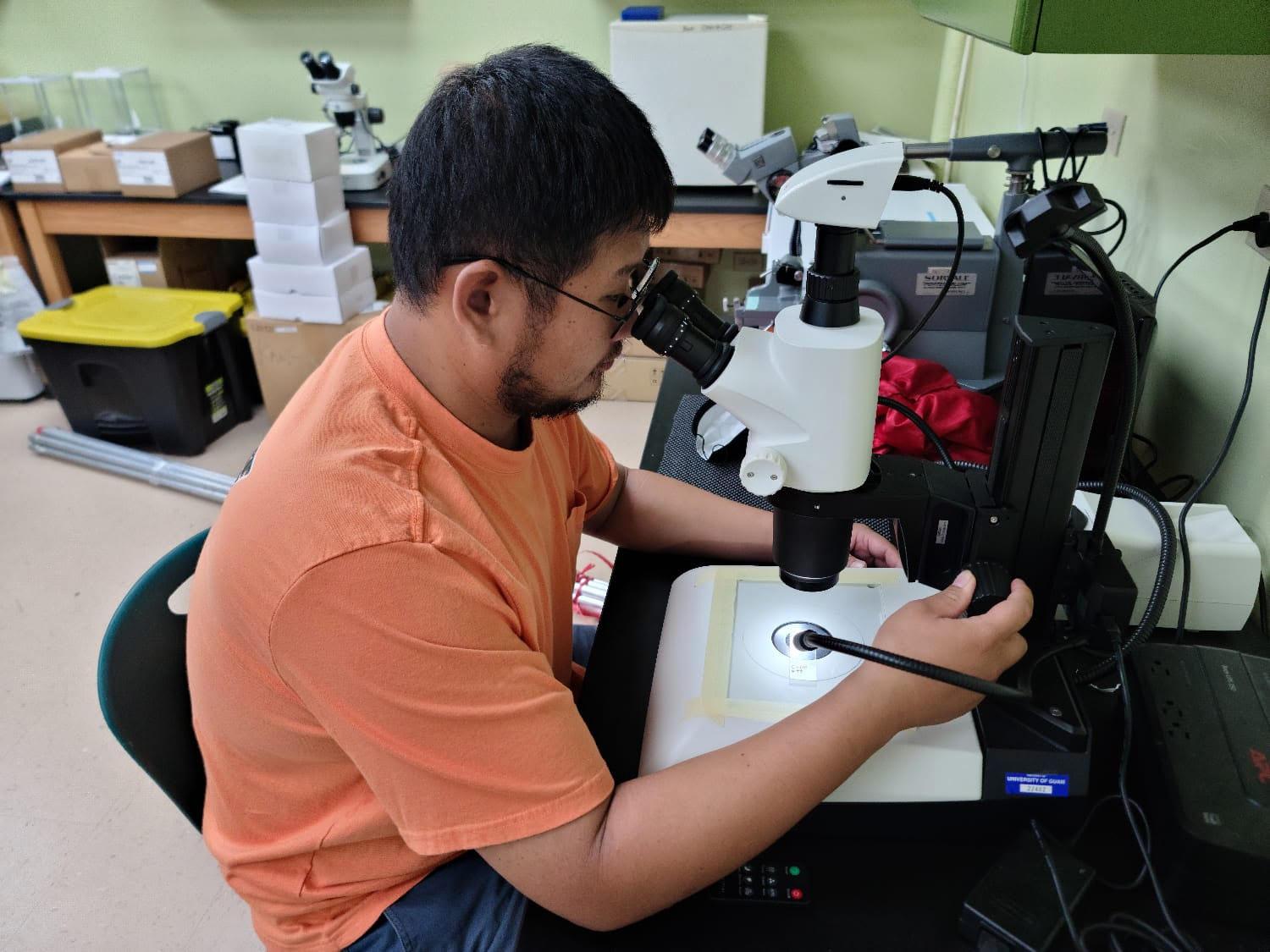


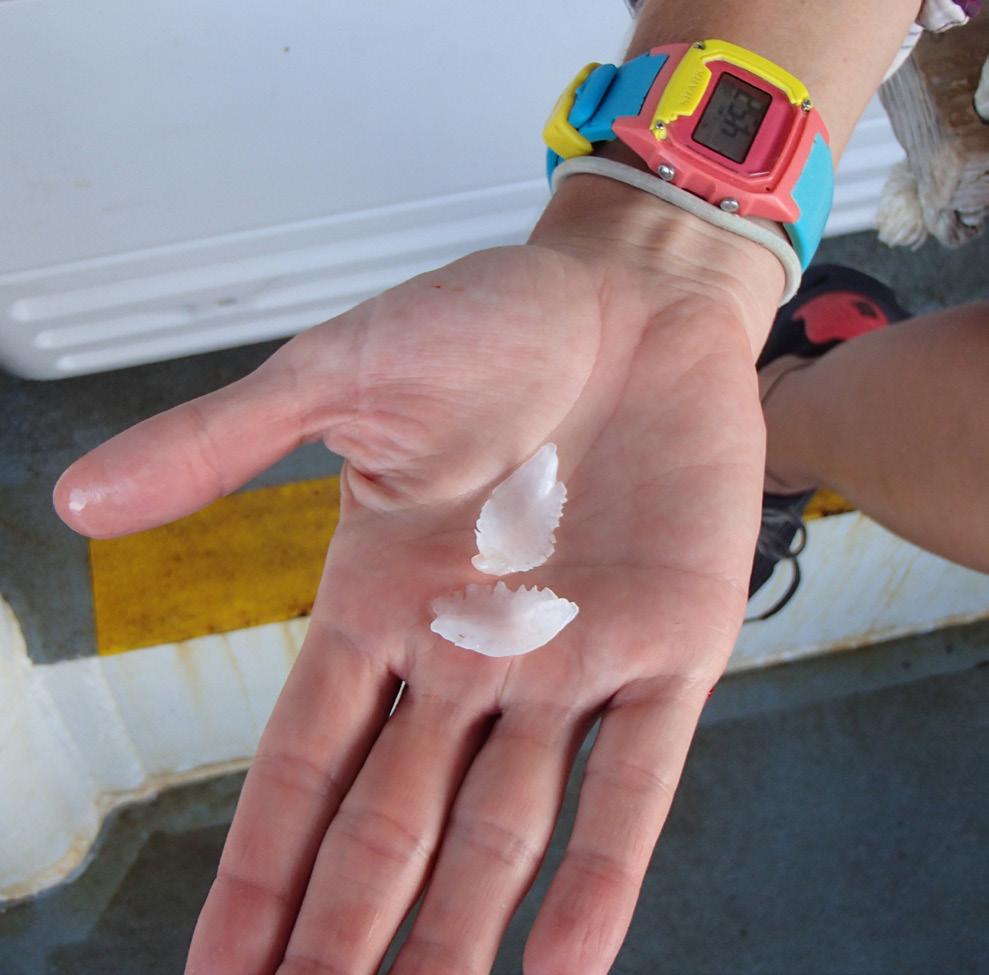
Fish Life History Biosamples
Fish Life History Biosamples
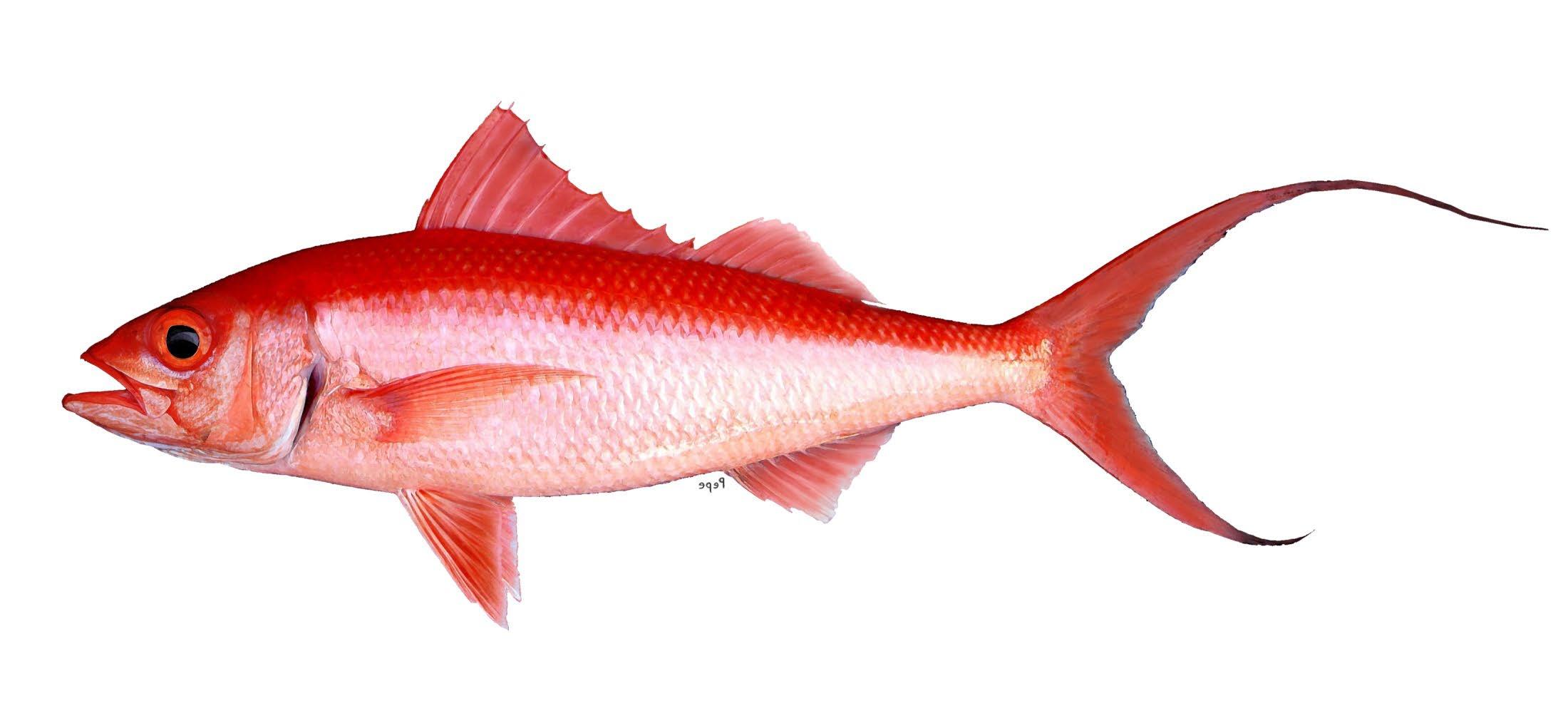

An o otolith (ear bone) forms annual lines, similar to the rings in a tree trunk. The distance between lines indicates fish relative growth each year.
Fork length, along with w weight, can be used for fish population assessments.
Gonads tell scientists information
reproductive
The st
mac
Section of a snapper otolith. Photo: NMFS/Joe O’Mal ey (L) Fish ovaries and (R) testes Photos: Pose don F sher es Research
about
development.
o
h contents show the fish’s diet.
Photo: Andrew Kang
Photo: WPRFMC

January 13 - February 10 Ineru 13 - Fibreru 10, 2024 MOON-RELATED OBSERVATIONS AND ACTIVITIES 13 14 15 16 17 18 19 20 21 22 23 24 25 26 27 28 29 30 31 1 23456789 10 SAT SUN MON TUE WED THU FRI SAT SUN MON TUE WED THU FRI SAT SUN MON TUE WED THU FRI SAT SUN MON TUE WED THU FRI SAT -1 0 1 2 3 -1 0 1 2 3 -1 0 1 2 3 6N6 6N6 6N6 6N6 6N6 6N6 6N6 6N6 6N6 6N6 6N6 6N6 6N6 6N6 6N6 6N6 6N6 6N6 6N6 6N6 6N6 6N6 6N6 6N6 6N6 6N6 6N6 6N6 6N6 January February R 08:19 S 20:03 R 09:10 S 21:05 R 09:56 S 22:04 R 10:39 S 23:00 R 11:20 S 23:55 R 12:01 S 00:49 R 12:43 S 01:44 R 13:29 S 02:41 R 14:17 S 03:39 R 15:09 S 04:36 R 16:04 S 05:31 R 16:59 S 06:22 R 17:54 S 07:08 R 18:46 S 07:50 R 19:36 S 08:28 R 20:23 S 09:03 R 21:09 S 09:37 R 21:53 S 10:10 R 22:38 S 10:44 R 23:24 S 11:20 R 00:12 S 11:59 R 01:04 S 12:42 R 02:00 S 13:32 R 03:00 S 14:28 R 04:02 S 15:30 R 05:03 S 16:36 R 06:02 S 17:42 R 06:56 S 18:46 Umayangan Sinahen Håcha Dengnga Humunaohuyong Pulan E’egeng Kuåtto Mangguånte Kuåtto Kosiente Sumenhomhom Kuåtto Ketai’ Empe’ Dalalai Pulan Sinahen Gunum Pulan Gualåffon Sinahen Ulu Sumahi I Pilan Pånglao Tunas/ Echong Hihot Talo’ Sinahen Fiti Mumalilingu Empe’ Finaloffan Puti’on Sinahen Lima Atahguen Atdao Halomsahguan Sinahen Tulu Gumofatanon Tunas Talo’ Sinahen Hugua Luma’annok Humomhom Sinahi
About This Calendar

The Western Pacific Regional Fishery Management Council has produced traditional lunar calendars for Guam since 2007. The intent is to enhance community involvement in fishery management.
In addition to sharing traditional and cultural knowledge about fishing, the 2023 Fanha’aniyan Pulan CHamoru (Chamorro Lunar Calendar) provides information about different ways that fisheries are monitored and kept healthy. The lunar months, moon phases and traditional calendar months are given in Chamorro, the native language of the indigenous people of Guam. The moon phases in this calendar are for Hagåtña as calculated by the HM Nautical Almanac (astro.ukho.gov.uk/websurf). The tide charts with moon rise and set times are in Chamorro Time for Hagåtña and were provided by OceanFun Publishing, NZ.
A special Un Dangkulu Na Si Yu’us Ma’ase to calendar contributors including Council family members Judith Amesbury, Ken and James Borja, Michael Dueñas, Audrey Toves; Council staff Floyd Masga, Felix Reyes, Amy Vandehey; Brent Tibbatts, Division of Aquatic and Wildlife Resources; Julian Flores, Andrew Kang, Stephen and Frances Meno, Leilani Sablan, Jimmy Snaer Badong, Southern High School Fishing Club.
For an electronic version of this calendar, go to www.wpcouncil.org/educationalresources/lunar calendars. Send us an email at info@wpcouncil.org to let us know how you use our calendar!
Front cover photo: Students from Marcial Sablan Elementary School learn the basics of fishing and caring for our marine resources. Photo: Stephen Meno
About the Council
The Western Pacific Regional Fishery Management Council was established by Congress in 1976 to manage fisheries in the offshore waters surrounding Guam, the Commonwealth of the Northern Mariana Islands, American Samoa, Hawai‘i and the U.S. Pacific Remote Island Areas. The fisheries in federal waters surrounding Guam are managed under the Mariana Archipelago and Pacific Pelagic Fishery Ecosystem Plans. Traditional knowledge and wide community involvement are integral parts of the ecosystem-based approach to fishery management.
Guam Contacts
Council Vice Chair Manny Dueñas II
Guam Fishermen’s Cooperative Association phone: (671) 472-6323 email: manny.duenas21@gmail.com
Council Member Judith Guthertz, PhD
University of Guam phone: (671) 488-5834 email: judithguthertz@gmail.com
Council Member Chelsa Muña-Brecht
Guam Department of Agriculture phone: (671) 300-7964 email: chelsa.munabrecht@doag.guam.gov
Guam Island Coordinator Felix Reyes phone: (671) 483-1904 email: felix.reyes@wpcouncil.org
Western Pacific Regional Fishery Management Council
1164 Bishop Street, Suite 1400 Honolulu, Hawai‘i 96813 phone: (808) 522-8220 email: info@wpcouncil.org web: www.wpcouncil.org
Published in the United States by the Western Pacific Regional Fishery Management Council under NOAA Award NA20NMF4410013.

©2022, Western Pacific Regional Fishery Management Council ISBN 978-1-950193-21-9
 Photo: Division of Aquatic and Wildlife Resources
Photo: Division of Aquatic and Wildlife Resources










 Photo: Division of Aquatic and Wildlife Resources
Photo: Felix Reyes
Photo: Felix Reyes
Photo: Division of Aquatic and Wildlife Resources
Photo: Felix Reyes
Photo: Felix Reyes



 Photo: Jimmy Badong
Photo: Felix Reyes
Photo: Jimmy Badong
Photo: Felix Reyes




 Fishermen know to respect our culture and its long history of caring for our environment, taking only what we need from our ocean.
Sesyun.
Photo: WPRFMC
A pile of mostly i’e. Photo: Felix Reyes
Photo: Division of Aquatic and Wildlife Resources
Fishermen know to respect our culture and its long history of caring for our environment, taking only what we need from our ocean.
Sesyun.
Photo: WPRFMC
A pile of mostly i’e. Photo: Felix Reyes
Photo: Division of Aquatic and Wildlife Resources




 Photo: Division of Aquatic and Wildlife Resources
Photo: Felix Reyes
Photo: Felix Reyes
Photo: Division of Aquatic and Wildlife Resources
Photo: Felix Reyes
Photo: Felix Reyes



 Photo: Michael Dueñas
Photo: Felix Reyes
Michael Dueñas demonstrates the parts of a small tuna to youth at the Guam Fishermen’s Cooperative Association, teaching them about food safety and how to take care of their catch. Eat only fresh fish that have clear eyes, a clean smell and are recently caught.
Photo: Michael Dueñas
Photo: Felix Reyes
Michael Dueñas demonstrates the parts of a small tuna to youth at the Guam Fishermen’s Cooperative Association, teaching them about food safety and how to take care of their catch. Eat only fresh fish that have clear eyes, a clean smell and are recently caught.




 Photos: Division of Aquatic and Wildlife Resources
Photos: Division of Aquatic and Wildlife Resources




 Photo: Leilani Sablan
Photo: Audrey Toves
Photo: Felix Reyes
Photo: Leilani Sablan
Photo: Audrey Toves
Photo: Felix Reyes



 Photo: Stephen Meno
Photo: Felix Reyes
Photo: Stephen Meno
Photo: Felix Reyes




 Photos: James Borja
Photo: Don Pedro Makaveli Cruz
Photos: James Borja
Photo: Don Pedro Makaveli Cruz




 Photos: Felix Reyes
Photos: Felix Reyes























 Photo: Division of Aquatic and Wildlife Resources
Photo: Division of Aquatic and Wildlife Resources